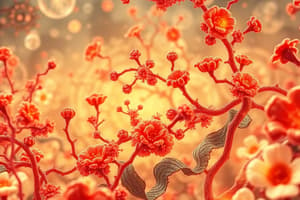Podcast
Questions and Answers
What is inflammation?
What is inflammation?
Inflammation is a dynamic response of vascularized tissue to injury.
Which of the following are considered characteristics of inflammation? (Select all that apply)
Which of the following are considered characteristics of inflammation? (Select all that apply)
- Pain (correct)
- Heat (correct)
- Swelling (correct)
- Loss of function (correct)
- Redness (correct)
What are the cardinal signs of inflammation?
What are the cardinal signs of inflammation?
Redness, warmth, pain, swelling, and loss of function.
Inflammation is a response to injury, while infection is the invasion of living tissue by pathogens.
Inflammation is a response to injury, while infection is the invasion of living tissue by pathogens.
In chronic inflammation, the inflammation involves ______ cells such as macrophages and lymphocytes.
In chronic inflammation, the inflammation involves ______ cells such as macrophages and lymphocytes.
Match the following outcomes with acute inflammation: Abscess formation, Progression to chronic inflammation, Resolution, Repair
Match the following outcomes with acute inflammation: Abscess formation, Progression to chronic inflammation, Resolution, Repair
What is edema?
What is edema?
What influences edema formation? (Select all that apply)
What influences edema formation? (Select all that apply)
Differentiate between exudate and transudate.
Differentiate between exudate and transudate.
Describe the difference between hyperemia and congestion.
Describe the difference between hyperemia and congestion.
What is hemorrhage?
What is hemorrhage?
Explain the process of regeneration in healing.
Explain the process of regeneration in healing.
What are the two main processes involved in healing?
What are the two main processes involved in healing?
What are the types of cells involved in healing and their characteristics?
What are the types of cells involved in healing and their characteristics?
Compare and contrast healing by first intention and second intention.
Compare and contrast healing by first intention and second intention.
What factors influence wound healing?
What factors influence wound healing?
Discuss the complications of wound healing.
Discuss the complications of wound healing.
What is acute inflammation?
What is acute inflammation?
Describe the processes involved in acute inflammation.
Describe the processes involved in acute inflammation.
List the sources of chemical mediators in inflammation and their functions.
List the sources of chemical mediators in inflammation and their functions.
Differentiate between exudate and transudate.
Differentiate between exudate and transudate.
Describe the types of acute inflammation.
Describe the types of acute inflammation.
List the beneficial and harmful effects of acute inflammation.
List the beneficial and harmful effects of acute inflammation.
Explain chronic inflammation and its causes.
Explain chronic inflammation and its causes.
What systemic effects can inflammation have?
What systemic effects can inflammation have?
Flashcards are hidden until you start studying
Study Notes
Inflammation Overview
- Definition: Inflammation is a dynamic response of vascularized tissue to injury, serving as a protective mechanism to bring defense and healing processes to the site of injury.
- Characteristics:
- Clinically: Heat, swelling, redness, pain, and loss of function
- Pathologically: Vasoconstriction followed by vasodilation, stasis, hyperemia, leukocyte accumulation, fluid exudation, and fibrin deposition
How Inflammation Occurs
- Mediated by chemical factors derived from blood plasma or cells, triggered by an inflammatory stimulus
- Tissue injury or death releases mediators
Etiologies of Inflammation
-
- Microbial infections (bacterial, viral, fungal, etc.)
-
- Physical agents (burns, trauma, radiation)
-
- Chemicals (drugs, toxins, caustic substances)
-
- Immunologic reactions (rheumatoid arthritis)
Cardinal Signs of Inflammation
- Redness: Hyperemia
- Warmth: Hyperemia
- Pain: Nerve chemical mediators
- Swelling: Exudation
- Loss of Function: Pain
Time Course of Inflammation
- Acute Inflammation: Less than 48 hours, mainly involving neutrophils
- Chronic Inflammation: More than 48 hours (weeks, months, years), involving mononuclear cells (macrophages, lymphocytes, plasma cells)
Types of Inflammation
- Acute Inflammation:
- Sudden onset
- Characteristic signs: Redness, swelling, pain, warmth, and loss of function
- Chronic Inflammation:
- Long duration (weeks, months, years, or lifetime)
- Examples: Asthma, allergy, diabetes, etc.
Inflammation vs. Infection
- Inflammation: Response to injury
- Infection: Invasion of living tissue by pathogens, causing inflammation
Pathogenesis
- Increased Blood Flow: Redness and warmth
- Increased Vascular Permeability: Swelling, pain, and loss of function
- Leukocytic Infiltration: Accumulation of leukocytes at the injury site
Local Manifestations of Acute Inflammation
- Vascular Dilation: Increased blood flow (erythema and warmth)
- Extravasation and Deposition: Plasma fluid and proteins (edema)
- Leukocyte Emigration: Accumulation at the injury site
Lymphatics in Inflammation
- Function: Draining edema
- Edema: Excess fluid in interstitial tissue or serous cavities (transudate or exudate)
- Types of Edema:
- Transudate: Ultrafiltrate of blood plasma, normal endothelium permeability, low protein content
- Exudate: Filtrate of blood plasma with inflammatory cells, altered endothelium permeability, high protein content
Hemodynamics Overview
- Introduction:
- The health and well-being of cells and tissues depend on intact circulation to deliver nutrients and maintain normal fluid homeostasis.
Water Distribution
- Intracellular: Within cells
- Extracellular: Includes interstitial (between cells) and intravascular (blood and lymph)
Edema
- Definition: Increased fluid accumulation in interstitial tissue spaces or body cavities
- Types:
- Hydrothorax: Fluid in the pleural cavity
- Hydropericardium: Fluid in the pericardial cavity
- Hydroperitoneum (Ascites): Fluid in the peritoneal cavity
- Anasarca: Severe, generalized edema with profound subcutaneous swelling
Mechanism of Edema
- Influenced by:
- Hydrostatic pressure
- Oncotic pressure
- Vascular permeability
- Lymphatic channels
- Sodium and water retention
Studying That Suits You
Use AI to generate personalized quizzes and flashcards to suit your learning preferences.



